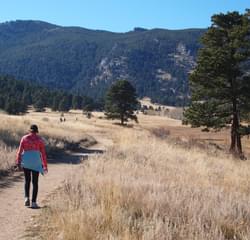




Planning Trails with Wildlife in Mind
Looking at resources from a regional or landscape-wide perspective helps identify where trails should go and which areas should be conserved for wildlife.

Landscape ecology provides many useful tools for understanding and documenting the landscapes through which trails pass. By identifying a landscape’s patches (such as stands of trees), corridors (e.g., a stream), and surrounding matrix (e.g., grasslands), it may be easier to find the best alignment for a trail, one that fits the landscape.
An important consideration in aligning a trail is the relative resiliency of habitats that might be crossed.
Not surprisingly, types of habitat vary widely in the number and kinds of wildlife using them. (Frequently habitat type is used as a surrogate for wildlife use because vegetation is easier to observe and map.)
For example, the 33 habitat types included in the Colorado Division of Wildlife’s “Latilong” data base potentially have a range from 35 species for tundra to 302 for lowland riparian areas.
The top two ranking habitat types, in terms of overall numbers of species and the most threatened or endangered species, are riparian, which illustrates why there is so much interest in conserving such areas found near water.
None of this is to suggest the number of species is the only or best measure of a habitat’s value to wildlife, although some habitats are used by more species of wildlife than others. Tundra, for example, because of its severe climate, has a low diversity of wildlife species. Yet tundra plays a vital role in the lives of species that are important components of Colorado’s biodiversity.
Lodgepole pine forests tend to have a moderate to low diversity of plants and animals. Because typically they are dense forests, recreationists may not be seen or heard by wildlife from as great a distance as open areas.
D.1 Variety of experience.
Route a trail through varied habitat types to enrich user experiences, but avoid small patches of species-rich habitats.
D.2 Potential vs. actual species.
Determine which species of interest actually occur in the area you are studying. Wildlife data bases sometimes list species that potentially occur within a given habitat type; not all of these species may actually be found there.
D.3 Screening.
Consider the physical characteristics of habitat types when routing a trail. For example, trail users may be screened in some forest types.
D.4 Habitat variability.
Even within a single type of habitat, some elements may be of greater importance to wildlife than others. For instance, shrubby thickets of snowberry or American plum within riparian habitat provide very important cover and food for birds and small mammals.
Use of habitats by wildlife varies widely. The number of wildlife species potentially found in the various types of habitat listed in the Colorado Division of Wildlife’s “Latilong” data base varies widely. This ranking shows why riparian areas are so significant to Colorado’s wildlife. Note: The data base includes mammals, birds, reptiles, and amphibians, but not fish. (Dave Weber, Colorado Division of Wildlife, 1998.)
[Older publications may be available from libraries and used booksellers. Titles with links may still be in print.]
Kruger, Frances Alley; John Fielder; and Carron A. Meaney, Denver Museum 1995. Explore Colorado: From Plains to Peaks.Westcliffe Publishers, Englewood, Colorado.
Sustaining Wildlife With Recreation on Public Lands
posted Nov 25, 2023
Humans and wildlife interact in multifaceted ways on public lands with both positive and negative outcomes for each group. When managed well, wildlife-based tourism and other forms of recreation can benefit conservation goals.
Environmental Impacts of Winter Recreation
posted Nov 25, 2023
Regardless of our intentions, many species perceive humans as a threat and respond accordingly. In general, animals respond to threats by first increasing vigilance (time spent looking around versus foraging), and running away if the threat is perceived to be imminent.
posted Nov 24, 2023
Winter recreation is a rapidly growing activity, and advances in technology make it possible for increasing numbers of people to access remote backcountry terrain. Increased winter recreation may lead to more frequent conflict between recreationists, as well as greater potential disturbance to wildlife.
Guidelines for Managing and Restoring Natural Plant Communities along Trails and Waterways
posted Sep 18, 2023
These guidelines are designed to assist resource managers in conducting management activities that enhance the quality of natural plant communities, wildlife habitat, regional landscape integrity and visual quality, particularly as related to planning, development, and maintenance of trails, water trails, and water access sites.
968 views • posted 09/08/2018